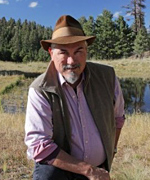Despite a slight uptick in the trend line from a 2012 release of Lake Powell water, by 2013 it was obvious that Lake Mead levels would continue to drop at least 12 ft/yr due to the structural deficit. Absent any further measures to bend that trend line, water supplies for the Lower Basin would continue to diminish. Shortage would be soon declared on the Colorado River as water levels dropped below 1,075 ft. This would invoke the 2007 Shortage Sharing Guidelines and, by 2025 (or earlier), the last water remaining in Lake Mead would belong solely to California, potentially with no deliveries to Arizona, Nevada, or Mexico. In turn, this would precipitate intervention by the Secretary of the Interior of the day (acting as Water Master of the Lower Basin), with unpredictable changes in policy by unknown people — and with uncertain implications for all three states, particularly California. Motivation to negotiate grew stronger as drought conditions worsened. Representatives of the Basin states and the Secretary of the Interior began meeting discreetly to discuss a framework for further measures. Their goals were to stabilize water-level elevations in the reservoirs, particularly Lake Mead, to ensure that some deliveries to Lower Basin contractors would continue and that no intervention by the Secretary of the Interior would occur.
In 2016, a tentative framework agreement was announced: the Drought Contingency Plan (DCP). Under the DCP, all Lower Basin states and the Bureau of Reclamation agree to voluntary reductions and increased system conservation. The goal is to insure that Lake Mead elevations do not drop below 1,025 ft and indeed stabilize above 1,045 ft. There will be sufficient water to allow some deliveries to all contractors. The DCP process represents collaboration between the Lower Basin states and Reclamation. Mexico is expected to join in, with a new Minute 32x to the 1944 water treaty between the two countries. The DCP will operate within the framework of the 2007 Shortage Sharing Guidelines as an overlay on that agreement. ADWR’s director is the lead negotiator for Arizona in the DCP talks. The CAP is heavily invested in the process, as it would bear the brunt of Arizona cuts.
The basic concept behind the DCP is much harsher cuts, much more quickly. Arizona and Nevada will take reductions in deliveries over what was specified in 2007. If Lake Mead water levels drop below 1,045 ft, California has agreed to accept a phased reduction of up to 350,000 acre-feet. This is a major breakthrough, since California, which has senior rights on the Colorado River, would have remained untouched under the 2007 guidelines. Shortage would be declared at 1,090 ft, well above the current elevation, and thus would be immediate upon Congressional approval of the DCP. Arizona would begin with a reduction of 192,000 acre-feet and, if Lake Mead water levels continue to drop, would eventually lose 720,000 acre-feet in a series of incremental steps. Nevada would take an immediate cut of 8,000 acre-feet, eventually increasing to 30,000 acre-feet. Reclamation would conserve 100,000 acre-feet from the start. The degree to which Mexico would participate is still unknown and must be negotiated by the U.S.
There is a dark side to the DCP. Pain will be felt by all three major sectors sharing the CAP water. Accelerated reductions in CAP deliveries under the DCP would generally follow the outlines of the 2007 shortage guidelines. The excess pool would disappear first, leaving CAGRD to scramble for recharge water to cover its growing replenishment obligations. The agricultural pool would take the next hit, but reductions would be more severe and much sooner than expected. The costs to replace that irrigation water with groundwater on short notice will be substantial. The Non-Indian Agricultural (NIA) pool would be next, and several cities with NIA allocations are worried. The municipal and tribal pools would be impacted last if the maximum cuts of 720,000 acre-feet were imposed. Cities are worried because an acceptable recovery plan for stored water is not yet in place. But this pain is necessary to preserve Arizona’s overall economy, which depends largely on CAP water.
The real dark side could lie in pressures to ease restrictions in the 1980 Groundwater Management Act. Already ADWR is seeing a spike in the number of Notices of Intent to drill or deepen nonexempt wells, as farmers and utilities rehabilitate old wells and plan new ones. Applications for Certificates of Assured Water Supply have also increased, which also implies renewed interest in groundwater pumping by developers (who have been abnormally quiet on the DCP so far). Arizona cannot afford to resume the overdrafting that was commonplace prior to the 1980 Groundwater Management Act. The protections afforded groundwater and stored water under that seminal law must be preserved. We must be on watch against any attempts at legislative or rule changes, lest the stresses of this century unravel the successes of the last.
